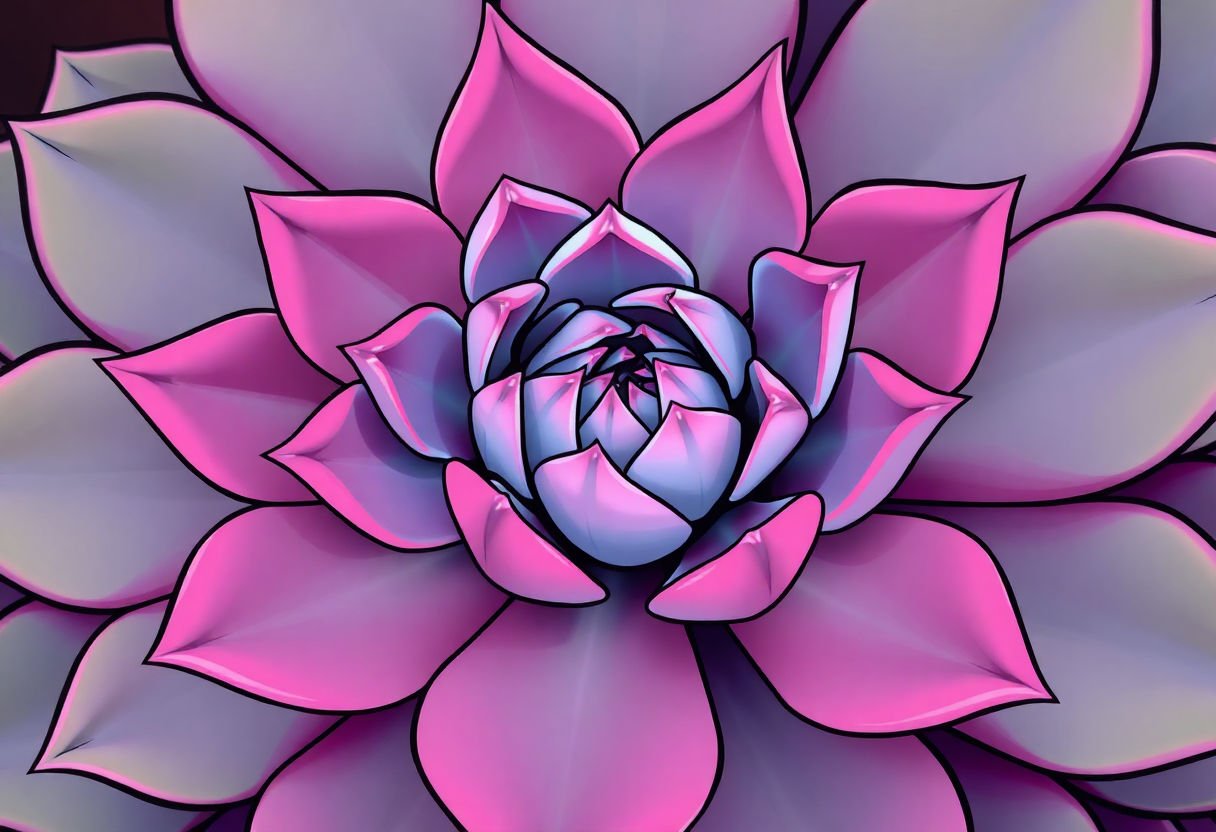For plant enthusiasts, nurturing blooming succulents is both a rewarding and intricate endeavor. These resilient plants require a unique blend of care to unlock their vibrant, picturesque blooms. From understanding their growth cycles to choosing ideal locations, mastering the essentials such as adequate sunlight, precise watering techniques, and optimal soil and fertilization can dramatically impact their blossoming success. Additionally, learning to manage pests and practice effective pruning and propagation is essential for thriving succulents. This comprehensive guide will equip you with the expert tips and tricks needed to keep your succulents flourishing continuously. Dive in to transform your plant care routine.
Key Takeaways
- Succulents thrive best with specific attention to their blooming needs, emphasizing unique care requirements during their growth cycles.
- Proper exposure to sunlight and meticulous watering routines are fundamental to nurturing healthy and vibrant succulent blooms.
- The selection of appropriate soil and the timing of fertilization are crucial to supporting optimal blooming in succulents.
- Recognizing the significance of location, which includes adequate sunlight and appropriate temperature, greatly impacts the blooming success of succulents.
- Regular monitoring and management of pests, coupled with effective pruning and propagation techniques, contribute to sustained blooming and plant health.
Understanding Succulent Growth Cycles
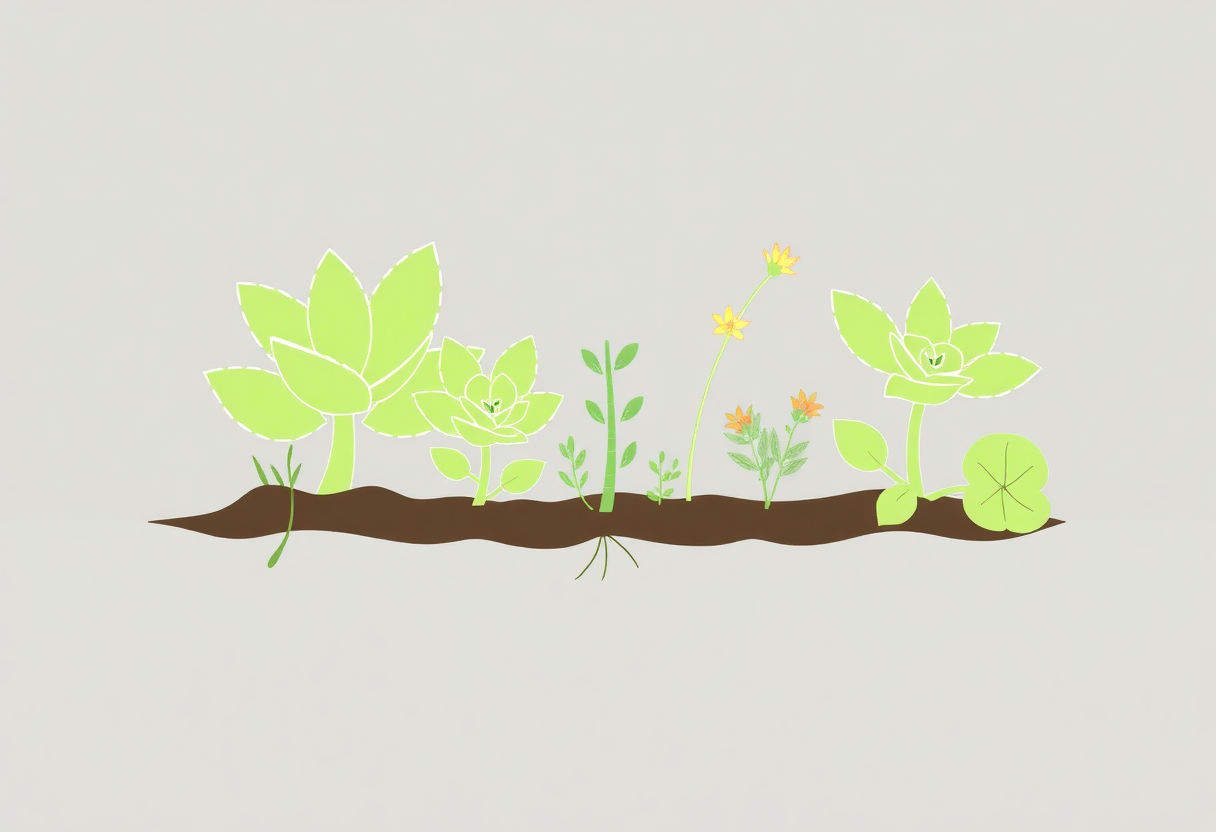 Succulents exhibit fascinating growth cycles that greatly influence their blooming patterns. Each phase of their lifecycle—from dormancy, growth, to flowering—presents unique needs and care requirements. Understanding these phases is essential for encouraging vibrant blooms and maintaining plant health.
Succulents exhibit fascinating growth cycles that greatly influence their blooming patterns. Each phase of their lifecycle—from dormancy, growth, to flowering—presents unique needs and care requirements. Understanding these phases is essential for encouraging vibrant blooms and maintaining plant health.
During the dormancy phase, which often occurs in the cooler months, succulents conserve energy. In this period, they require minimal watering, as excessive moisture can lead to root rot. As temperatures rise, succulents enter the active growth stage, necessitating more frequent watering and sunlight exposure to support new leaf and stem development. This stage is crucial for strengthening the plant in preparation for blooming.
Flowering typically occurs during the warmest months when sunlight is abundant. Signs that a succulent is ready to bloom include the emergence of buds and increased stem growth. It is essential to ensure that these plants receive adequate sunlight and optimal temperatures during this time. According to research found in various succulent lifecycle stages, this balance supports robust flowering and overall plant vitality.
To promote successful blooms, maintaining consistent care tailored to each growth cycle is imperative. Regularly checking soil moisture levels, providing appropriate fertilization, and monitoring for pests can enhance the blooming potential. By aligning care routines with the stages of a succulent’s lifecycle, gardeners can ensure their plants not only survive but thrive, showcasing the magnificent blooms that these resilient plants are capable of producing. Understanding these cyclical patterns allows enthusiasts to enjoy the full beauty and diversity that succulents have to offer.
Choosing the Right Location for Succulents
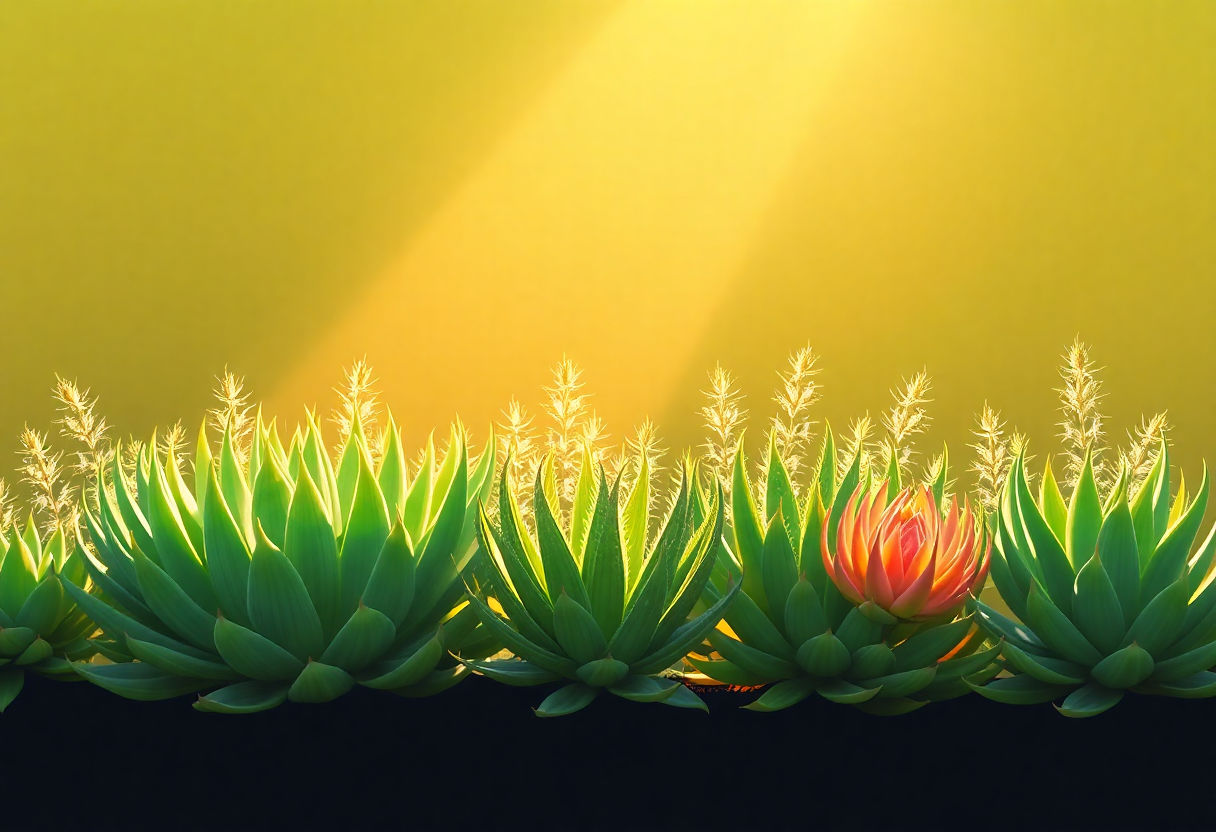 Positioning your succulents in an appropriate location is crucial for their blooming success. Optimal sunlight exposure and precise temperature control are two primary factors that determine whether these resilient plants thrive or struggle to bloom.
Positioning your succulents in an appropriate location is crucial for their blooming success. Optimal sunlight exposure and precise temperature control are two primary factors that determine whether these resilient plants thrive or struggle to bloom.
Sunlight Exposure: Succulents generally require ample sunlight to flourish. Most varieties thrive in bright, indirect light; however, too much direct sunlight can lead to leaf scorch. Ideally, place them in an area where they can receive at least six hours of light per day. For indoor settings, positioning your succulents near a south or east-facing window often yields the best results. For those new to indoor succulent placement, balancing light exposure while avoiding direct midday sun is key.
Temperature Considerations: Succulents favor warm environments with temperatures ranging from 60°F to 80°F. While they can endure slightly cooler nights, ensuring a stable temperature during the day is essential for consistent blooming. Avoid placing succulents near drafty windows or air conditioning units, where temperature fluctuations can cause stress.
Microclimates and Environmental Factors: Creating a favorable microclimate for your succulents can enhance their ability to bloom. Consider cultural variations in humidity and airflow, which play a significant role alongside temperature and sunlight. Elevated humidity levels, common in bathrooms or kitchens, may not serve succulents well. Similarly, stagnant air can promote pests and diseases, so ensure adequate ventilation.
In summary, selecting the right location involves balancing sunshine, temperature, and environmental factors, contributing significantly to the prosperity of your blooming succulents.
Watering Techniques for Blooming Succulents
Proper watering is pivotal in maintaining the health and vibrant blooms of your succulents. These hardy plants have evolved to store water in their thick leaves and stems, allowing them to thrive in arid environments. However, understanding the specific needs of blooming succulents can further enhance their growth and flowering.
One of the most fundamental principles is the “soak and dry” method. This technique involves soaking the soil thoroughly and allowing it to dry out completely before the next watering. This mimics the natural rainfall they experience in their native habitats, promoting strong root growth and reducing the risk of root rot.
It’s essential to use a well-draining soil mix, as it facilitates the drying process and prevents waterlogging. A mix containing perlite or pumice alongside standard potting soil can be beneficial. You can find additional and in-depth information on implementing these practices effectively in this blooming succulent watering guide.
The frequency of watering is critical and must be adjusted according to environmental conditions. During the active growing and blooming season, succulents may require more frequent watering, whereas, in dormancy, monthly watering might suffice. Additionally, factors such as pot size, location, and climate can significantly influence watering needs.
To test soil moisture, consider using a moisture meter or simply insert your finger into the soil to ensure it’s dry before watering again. By mastering these techniques, you can foster a thriving environment for your blooming succulents, ensuring they continue to flourish and display their colorful blooms.
Soil and Fertilization for Optimal Blooming
To achieve optimal blooming, succulents require specific soil conditions and fertilization practices. The right soil provides essential nutrients and proper drainage, while fertilization enhances growth and bloom quality.
Ideal Soil Composition
Succulents thrive in a soil mix that ensures good aeration and quick drainage. A typical succulent soil includes:
- Coarse Sand or Grit: Enhances drainage by preventing water retention.
- Perlite or Pumice: Provides aeration, reducing the risk of root rot.
- Quality Potting Soil: A small percentage of organic matter aids nutrient supply.
Tip: Avoid garden soil as it tends to compact and retains excessive moisture, which can harm succulents.
Fertilization Techniques
While succulents need fewer nutrients than many plants, proper fertilization encourages blossoming. Utilize a balanced, water-soluble fertilizer, such as a 10-10-10 or 8-8-8 NPK ratio. The preferred schedule includes:
- Active Growth Phase Fertilization: Apply a diluted dose of fertilizer every 3 to 4 weeks during spring and summer.
- Dormant Period Avoidance: Refrain from fertilizing in fall and winter when succulents are often dormant.
Note: “Less is more” applies to fertilization—the excess can burn roots and inhibit blooming.
Soil and fertilization are pivotal in supporting the blooming process of succulents. Selecting the right soil mix and fertilizing judiciously, especially during the growth season, will significantly enhance the chance of vibrant, healthy blossoms. Adhering to these practices ensures that your charming succulents reach their full blooming potential.
Common Pests and How to Manage Them
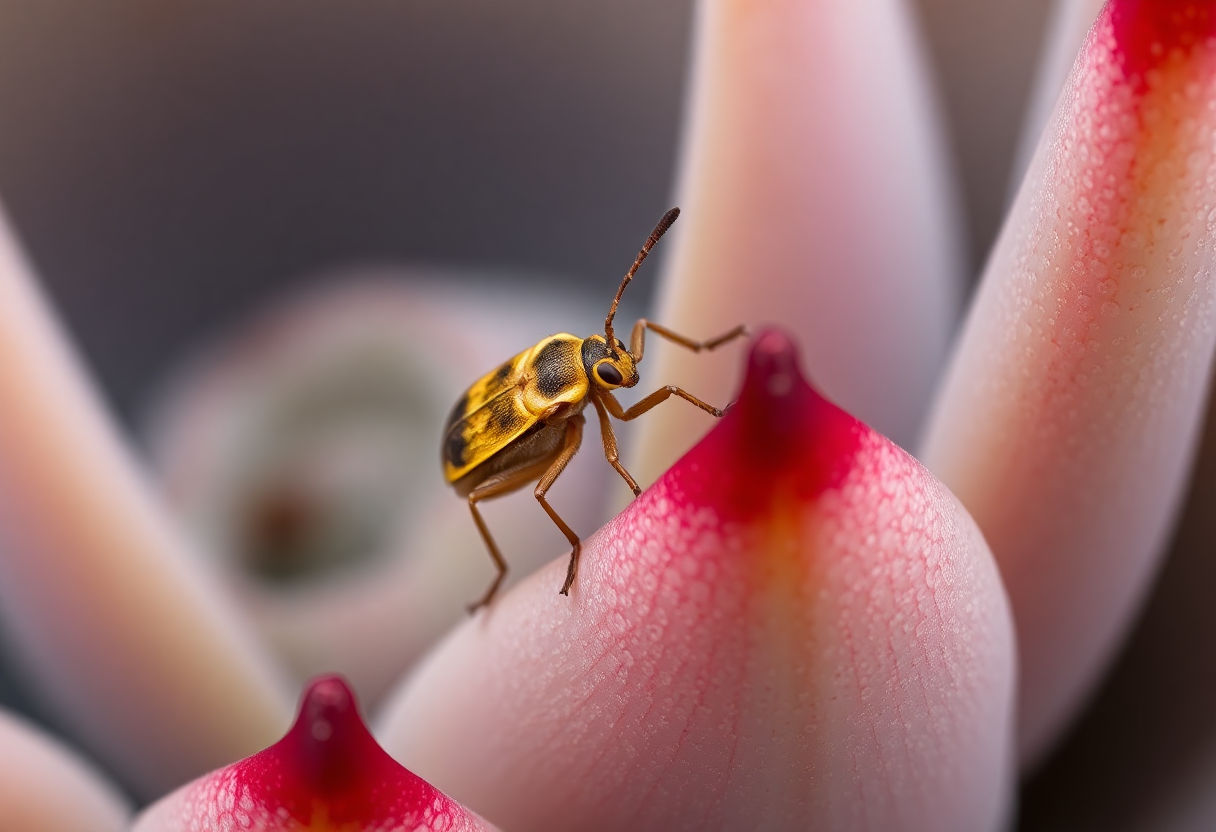 When cultivating blooming succulents, one inevitable challenge is managing common pests that threaten their health and vibrancy. Mealybugs, scale insects, spider mites, and aphids are some of the most pervasive pests affecting succulents. Each harbors unique characteristics yet causes significant damage if not addressed promptly.
When cultivating blooming succulents, one inevitable challenge is managing common pests that threaten their health and vibrancy. Mealybugs, scale insects, spider mites, and aphids are some of the most pervasive pests affecting succulents. Each harbors unique characteristics yet causes significant damage if not addressed promptly.
Mealybugs are small, white insects that secrete a cotton-like wax over plants, leading to weakened growth and bloom failure. Regular inspection and use of insecticidal soap can prevent infestations. For scale insects, which form protective shells, manual removal with a toothbrush dipped in alcohol is effective. They attach firmly to stems and leaves, sapping essential nutrients.
Spider mites, identifiable as tiny red dots, thrive in dry conditions and leave fine webs on plants. Introducing a gentle misting routine and employing neem oil can deter their proliferation. Aphids are often green but can vary in color, leading to distorted leaves and stunted blooms. Effective management of aphids can be found on this informative resource, detailing the necessary steps to protect your succulents: Aphid control succulents.
Prevention strategies are pivotal. Consider integrating beneficial insects such as ladybugs, known for consuming pests like aphids and mealybugs, into your garden. Furthermore, cleanliness plays a significant role; keeping the area around your succulents tidy minimizes pest attraction. Regularly remove dead leaves and debris which can harbor these unwelcome guests.
In conclusion, swift identification and implementation of these control measures will ensure your succulent blooms remain vibrant and healthy throughout their growth cycles.
Pruning and Propagation Tips
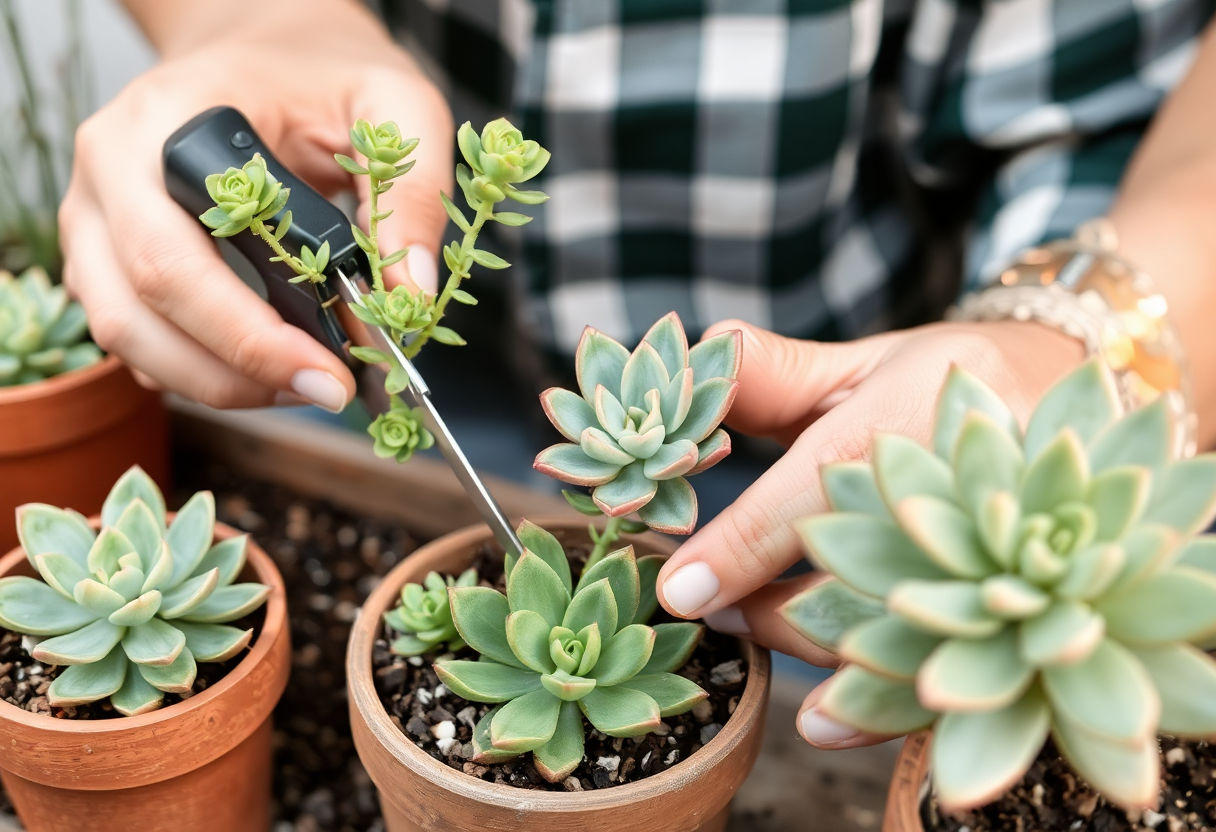 Pruning and propagating your succulents are essential practices for maintaining their health and enhancing their blooming potential. Pruning involves trimming the plant to remove dead or overgrown parts, which helps in redirecting the plant’s energy towards promoting vibrant blooms and new growth. Regular pruning can prevent the plant from becoming leggy and can also help manage its size. For detailed guidance on pruning methods and techniques, refer to this succulent pruning guide.
Pruning and propagating your succulents are essential practices for maintaining their health and enhancing their blooming potential. Pruning involves trimming the plant to remove dead or overgrown parts, which helps in redirecting the plant’s energy towards promoting vibrant blooms and new growth. Regular pruning can prevent the plant from becoming leggy and can also help manage its size. For detailed guidance on pruning methods and techniques, refer to this succulent pruning guide.
When it comes to propagation, succulents offer multiple methods that can help expand your collection effortlessly. The most common approaches include:
-
Leaf Propagation: Gently twist a healthy leaf from the main plant and let it dry for a few days until a callus forms. Place it on well-draining soil, and roots will eventually develop.
-
Stem Cuttings: Cut a healthy stem from the main plant, allowing it to dry until a callus forms before placing it in the soil. This method is beneficial for more significant propagation needs.
-
Offsets Division: Many succulents produce offsets, or “pups,” which can be separated from the parent plant and potted individually. This approach is effective for plants like echeverias and sempervivums.
Understanding the specific needs of your succulent species is crucial in choosing the right propagation method. Ensure that your tools are sanitized to minimize the risk of disease. By integrating these practices into your routine, you can maintain a thriving, beautiful succulent garden.
Recognizing and Reviving Unhealthy Succulents
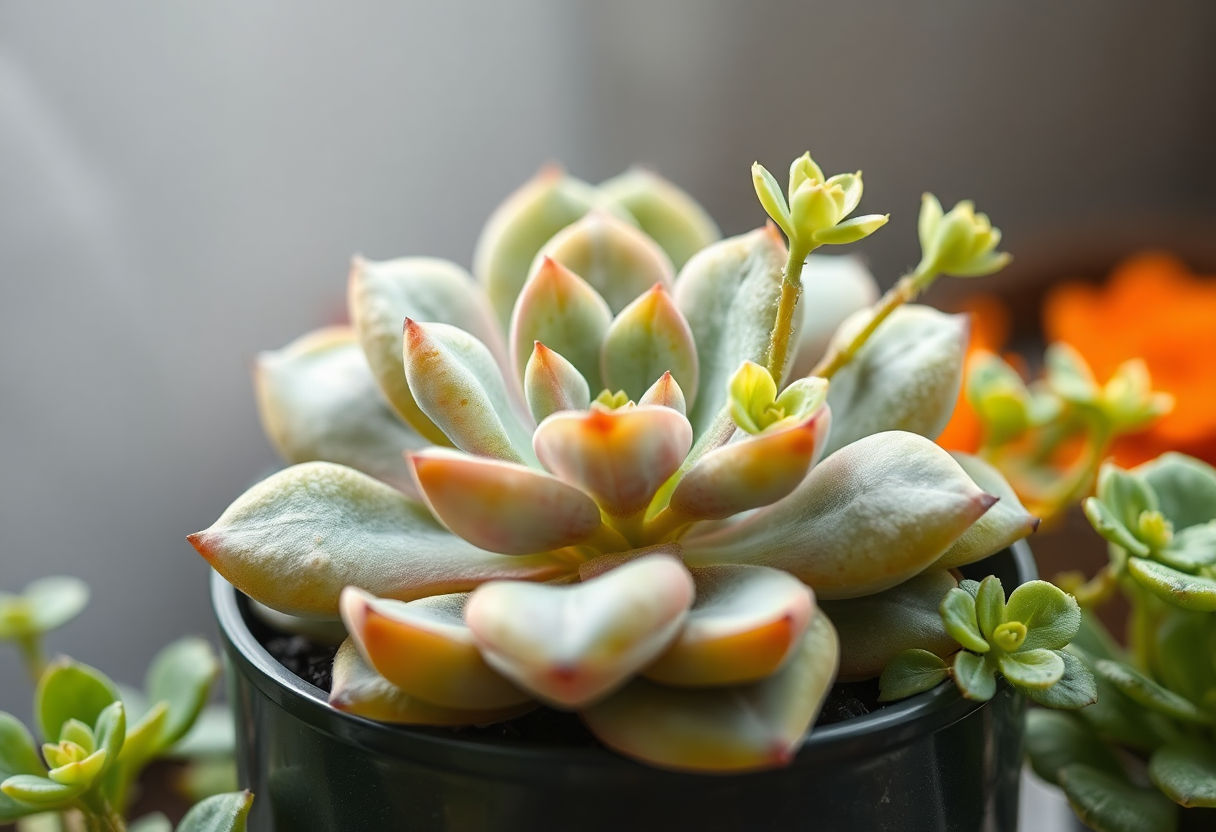 Caring for succulents can be both rewarding and challenging, particularly when they show signs of stress or illness. Recognizing early indicators of unhealthy succulents is essential to prevent further deterioration and to maintain their blooming capability. Common signs of distress include discoloration, sagging leaves, or a drastic change in growth patterns. Often, these symptoms are linked to environmental conditions or improper care techniques.
Caring for succulents can be both rewarding and challenging, particularly when they show signs of stress or illness. Recognizing early indicators of unhealthy succulents is essential to prevent further deterioration and to maintain their blooming capability. Common signs of distress include discoloration, sagging leaves, or a drastic change in growth patterns. Often, these symptoms are linked to environmental conditions or improper care techniques.
Discoloration, for instance, may suggest over-exposure to sunlight or insufficient watering. In contrast, leaves that are soft and mushy are typically a result of over-watering. Ensuring that your succulents have adequate drainable soil and are watered appropriately is key to avoiding these issues.
Once you have identified an unhealthy succulent, prompt action to revive it is necessary. Start by adjusting the environmental factors contributing to the problem. Relocate the plant to a more suitable area, offering the right balance of sunlight and shade. Modify your watering schedule to align with the plant’s needs, ensuring that the soil dries out adequately before the next watering.
In certain situations, it might be beneficial to reassess the plant’s root health as well. For comprehensive guidance on identifying root health issues and appropriate remedies without disrupting the overall well-being of your succulents, consider referring to reliable resources. Additionally, pruning damaged leaves can stimulate new growth and enhance blooming. Fostering healthier growth through these methods will greatly improve the longevity and vitality of your succulents, leading to a more vibrant and resilient plant collection.
Conclusion
Successfully maintaining blooming succulents hinges on understanding and catering to their unique needs. By embracing mindful practices such as strategic location selection, proper watering, and adequate soil and fertilization, gardeners can ensure vibrant and consistent blooms. As bloom cycles vary with species, staying attuned to each plant’s specific requirements opens opportunities for stunning displays year-round. Embrace the challenge of succulent care with persistence and patience—a fulfilling journey that rewards with exquisite floral beauty.
Frequently Asked Questions
How often should I water my blooming succulents?
Blooming succulents typically require watering once every two weeks, but this can vary based on the humidity and temperature of your environment. Ensure the soil is completely dry before watering again to prevent root rot.
What is the best type of soil for blooming succulents?
Succulents thrive in well-draining soil, often a mixture of cactus soil or a gritty compost blend. This type of soil prevents water from pooling around the roots, reducing the risk of rot.
How much sunlight do blooming succulents need?
Blooming succulents generally need about six hours of bright, indirect sunlight daily. Too much direct sun can scorch them, while too little can hinder their blooming.
How can I manage pests on my succulents?
Regularly inspect your succulents for common pests such as aphids and mealybugs. Use insecticidal soap or neem oil as effective solutions to control infestations while minimizing harm to your plants.
When and how should I fertilize my blooming succulents?
Fertilize your succulents once a month during the growing season, typically spring and summer. Use a balanced, water-soluble fertilizer diluted to half strength to promote healthy blooms without over-feeding the plant.
